斯坦福卫生经济学教材(Health Economics)杰伊·巴塔查里亚《健康经济学》课程教学资源(PPT课件,英文版)Chapter 07 DEMAND FOR INSURANCE
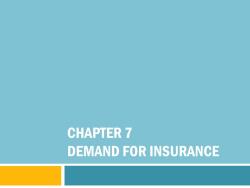
CHAPTER 7 DEMAND FOR INSURANCE
CHAPTER 7 DEMAND FOR INSURANCE
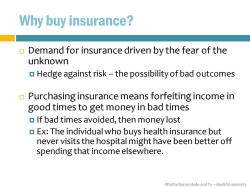
Why buy insurance? Demand for insurance driven by the fear of the unknown Hedge against risk--the possibility of bad outcomes Purchasing insurance means forfeiting income in good times to get money in bad times If bad times avoided,then money lost Ex:The individual who buys health insurance but never visits the hospital might have been better off spending that income elsewhere. Bhattacharya,Hyde and Tu-HealthEconomics
Bhattacharya, Hyde and Tu – Health Economics Why buy insurance? Demand for insurance driven by the fear of the unknown Hedge against risk -- the possibility of bad outcomes Purchasing insurance means forfeiting income in good times to get money in bad times If bad times avoided, then money lost Ex: The individual who buys health insurance but never visits the hospital might have been better off spending that income elsewhere
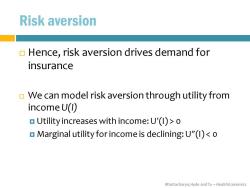
Risk aversion Hence,risk aversion drives demand for insurance We can model risk aversion through utility from income U(I) Utility increases with income:U'(1)>o Marginal utility for income is declining:U"(1)<o Bhattacharya,Hyde and Tu-HealthEconomics
Bhattacharya, Hyde and Tu – Health Economics Risk aversion Hence, risk aversion drives demand for insurance We can model risk aversion through utility from income U(I) Utility increases with income: U(I) > 0 Marginal utility for income is declining: U(I) < 0
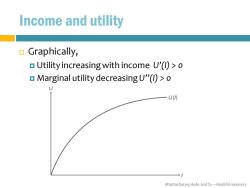
Income and utility Graphically, Utility increasing with income U'(l)>o Marginal utility decreasing U"(1)>o U() → Bhattacharya,Hyde and Tu-HealthEconomics
Bhattacharya, Hyde and Tu – Health Economics Income and utility Graphically, Utility increasing with income U’(I) > 0 Marginal utility decreasing U’’(I) > 0
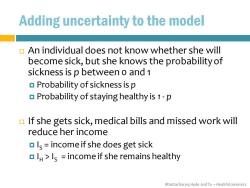
Adding uncertainty to the model An individual does not know whether she will become sick,but she knows the probability of sickness is p between o and 1 Probability of sickness is p Probability of staying healthy is 1-p If she gets sick,medical bills and missed work will reduce her income Is=income if she does get sick IH>Is=income if she remains healthy Bhattacharya,Hyde and Tu-HealthEconomics
Bhattacharya, Hyde and Tu – Health Economics Adding uncertainty to the model An individual does not know whether she will become sick, but she knows the probability of sickness is p between 0 and 1 Probability of sickness is p Probability of staying healthy is 1 - p If she gets sick, medical bills and missed work will reduce her income IS = income if she does get sick IH > IS = income if she remains healthy
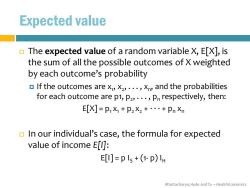
Expected value The expected value of a random variable X,E[X],is the sum of all the possible outcomes of X weighted by each outcome's probability If the outcomes are x,x2,...,n,and the probabilities for each outcome are p1,p2,...,Pn respectively,then: E[X]=PX+p2X2+..+Pn Xn In our individual's case,the formula for expected value of income E[l]: [叮=pls+(1p)lH Bhattacharya,Hyde and Tu-HealthEconomics
Bhattacharya, Hyde and Tu – Health Economics Expected value The expected value of a random variable X, E[X], is the sum of all the possible outcomes of X weighted by each outcome’s probability If the outcomes are x1 , x2 , . . . , xn , and the probabilities for each outcome are p1, p2 , . . . , pn respectively, then: E[X] = p1 x1 + p2 x2 + · · · + pn xn In our individual’s case, the formula for expected value of income E[I]: E[I] = p IS + (1- p) IH
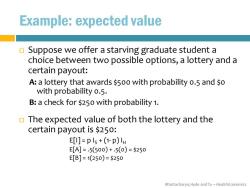
Example:expected value Suppose we offer a starving graduate student a choice between two possible options,a lottery and a certain payout: A:a lottery that awards $500 with probability o.5 and so with probability o.5. B:a check for $250 with probability 1. The expected value of both the lottery and the certain payout is $250: E[I]=pIs+(1-p)I E[A]=.5(500)+.5(o)=$250 E[B]=1(250)=250 Bhattacharya,Hyde and Tu-HealthEconomics
Bhattacharya, Hyde and Tu – Health Economics Example: expected value Suppose we offer a starving graduate student a choice between two possible options, a lottery and a certain payout: A: a lottery that awards $500 with probability 0.5 and $0 with probability 0.5. B: a check for $250 with probability 1. The expected value of both the lottery and the certain payout is $250: E[I] = p IS + (1- p) IH E[A] = .5(500) + .5(0) = $250 E[B] = 1(250) = $250
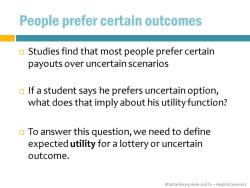
People prefer certain outcomes Studies find that most people prefer certain payouts over uncertain scenarios If a student says he prefers uncertain option, what does that imply about his utility function? To answer this question,we need to define expected utility for a lottery or uncertain outcome. Bhattacharya,Hyde and Tu-HealthEconomics
Bhattacharya, Hyde and Tu – Health Economics People prefer certain outcomes Studies find that most people prefer certain payouts over uncertain scenarios If a student says he prefers uncertain option, what does that imply about his utility function? To answer this question, we need to define expected utility for a lottery or uncertain outcome
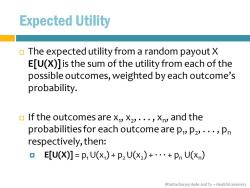
Expected Utility The expected utility from a random payout X E[U(X)]is the sum of the utility from each of the possible outcomes,weighted by each outcome's probability. If the outcomes are x,X2,...,Xn,and the probabilities for each outcome are p,,P2,...,Pn respectively,then: ▣E[U(X)]=PU(x)+P2U(x2)+·+PnU(xn) Bhattacharya,Hyde and Tu-HealthEconomics
Bhattacharya, Hyde and Tu – Health Economics Expected Utility The expected utility from a random payout X E[U(X)]is the sum of the utility from each of the possible outcomes, weighted by each outcome’s probability. If the outcomes are x1 , x2 , . . . , xn , and the probabilities for each outcome are p1 , p2 , . . . , pn respectively, then: E[U(X)] = p1 U(x1 ) + p2 U(x2 ) + · · · + pn U(xn )
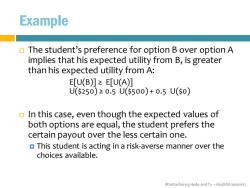
Example The student's preference for option B over option A implies that his expected utility from B,is greater than his expected utility from A: E[U(B)]≥E[U(A)] U(525o)20.5U(500)+0.5U(50) In this case,even though the expected values of both options are equal,the student prefers the certain payout over the less certain one. This student is acting in a risk-averse manner over the choices available. Bhattacharya,Hyde and Tu-HealthEconomics
Bhattacharya, Hyde and Tu – Health Economics Example The student’s preference for option B over option A implies that his expected utility from B, is greater than his expected utility from A: E[U(B)] ≥ E[U(A)] U($250) ≥ 0.5 U($500) + 0.5 U($0) In this case, even though the expected values of both options are equal, the student prefers the certain payout over the less certain one. This student is acting in a risk-averse manner over the choices available
按次数下载不扣除下载券;
注册用户24小时内重复下载只扣除一次;
顺序:VIP每日次数-->可用次数-->下载券;
- 斯坦福卫生经济学教材(Health Economics)杰伊·巴塔查里亚《健康经济学》课程教学资源(PPT课件,英文版)Chapter 06 THE HOSPITAL INDUSTRY.ppt
- 斯坦福卫生经济学教材(Health Economics)杰伊·巴塔查里亚《健康经济学》课程教学资源(PPT课件,英文版)Chapter 05 THE PHYSICIAN LABOR MARKET.ppt
- 斯坦福卫生经济学教材(Health Economics)杰伊·巴塔查里亚《健康经济学》课程教学资源(PPT课件,英文版)Chapter 04 SOCIOECONOMIC DISPARITIES IN HEALTH.ppt
- 斯坦福卫生经济学教材(Health Economics)杰伊·巴塔查里亚《健康经济学》课程教学资源(PPT课件,英文版)Chapter 03 CHAPTER 3 DEMAND FOR HEALTH:THE GROSSMAN MODEL.ppt
- 斯坦福卫生经济学教材(Health Economics)杰伊·巴塔查里亚《健康经济学》课程教学资源(PPT课件,英文版)Chapter 24 TIME INCONSISTENCY AND HEALTH.ppt
- 斯坦福卫生经济学教材(Health Economics)杰伊·巴塔查里亚《健康经济学》课程教学资源(PPT课件,英文版)Chapter 23 PROSPECT THEORY.ppt
- 斯坦福卫生经济学教材(Health Economics)杰伊·巴塔查里亚《健康经济学》课程教学资源(PPT课件,英文版)Chapter 22 OBESITY.ppt
- 斯坦福卫生经济学教材(Health Economics)杰伊·巴塔查里亚《健康经济学》课程教学资源(PPT课件,英文版)Chapter 21 ECONOMIC EPIDEMIOLOGY.ppt
- 斯坦福卫生经济学教材(Health Economics)杰伊·巴塔查里亚《健康经济学》课程教学资源(PPT课件,英文版)Chapter 20 THE ECONOMICS OF HEALTH EXTERNALITIES.ppt
- 斯坦福卫生经济学教材(Health Economics)杰伊·巴塔查里亚《健康经济学》课程教学资源(PPT课件,英文版)Chapter 02 DEMAND FOR HEALTH CARE.ppt
- 斯坦福卫生经济学教材(Health Economics)杰伊·巴塔查里亚《健康经济学》课程教学资源(PPT课件,英文版)Chapter 19 POPULATION AGING AND THE FUTURE OF HEALTH POLICY.ppt
- 斯坦福卫生经济学教材(Health Economics)杰伊·巴塔查里亚《健康经济学》课程教学资源(PPT课件,英文版)Chapter 18 THE AMERICAN MODEL.ppt
- 斯坦福卫生经济学教材(Health Economics)杰伊·巴塔查里亚《健康经济学》课程教学资源(PPT课件,英文版)Chapter 17 THE BISMARCK MODEL - SOCIAL HEALTH INSURANCE.ppt
- 斯坦福卫生经济学教材(Health Economics)杰伊·巴塔查里亚《健康经济学》课程教学资源(PPT课件,英文版)Chapter 16 THE BEVERIDGE MODEL - NATIONALIZED HEALTH CARE.ppt
- 斯坦福卫生经济学教材(Health Economics)杰伊·巴塔查里亚《健康经济学》课程教学资源(PPT课件,英文版)Chapter 15 THE HEALTH POLICY CONUNDRUM.ppt
- 斯坦福卫生经济学教材(Health Economics)杰伊·巴塔查里亚《健康经济学》课程教学资源(PPT课件,英文版)Chapter 14 HEALTH TECHNOLOGY ASSESSMENT.ppt
- 斯坦福卫生经济学教材(Health Economics)杰伊·巴塔查里亚《健康经济学》课程教学资源(PPT课件,英文版)Chapter 13 TECHNOLOGY AND THE PRICE OF HEALTH CARE.ppt
- 斯坦福卫生经济学教材(Health Economics)杰伊·巴塔查里亚《健康经济学》课程教学资源(PPT课件,英文版)Chapter 12 PHARMACEUTICALS AND THE ECONOMICS OF INNOVATION.ppt
- 斯坦福卫生经济学教材(Health Economics)杰伊·巴塔查里亚《健康经济学》课程教学资源(PPT课件,英文版)Chapter 11 MORAL HAZARD.ppt
- 斯坦福卫生经济学教材(Health Economics)杰伊·巴塔查里亚《健康经济学》课程教学资源(PPT课件,英文版)Chapter 10 ADVERSE SELECTION IN REAL MARKETS.ppt
- 斯坦福卫生经济学教材(Health Economics)杰伊·巴塔查里亚《健康经济学》课程教学资源(PPT课件,英文版)Chapter 08 ADVERSE SELECTION - AKERLOF’S MARKET FOR LEMONS.ppt
- 斯坦福卫生经济学教材(Health Economics)杰伊·巴塔查里亚《健康经济学》课程教学资源(PPT课件,英文版)Chapter 09 ADVERSE SELECTION - THE ROTHSCHILD-STIGLITZ MODEL.ppt
- 兰州交通大学:《微观经济学》课程教学资源(教案大纲)教学大纲 Microeconomics(负责人:李新文).pdf
- 兰州交通大学:《微观经济学》课程教学资源(教案大纲)微观经济学授课教案(打印版).pdf
- 兰州交通大学:《微观经济学》课程教学资源(案例分析)微观经济学教学案例(打印版).pdf
- 《微观经济学》课程教学资源(书籍文献)西方经济学名著选读.pdf
- 兰州交通大学:《微观经济学》课程教学资源(试卷习题)微观经济学各章习题库及参考答案(打印版,共十一章).pdf
- 兰州交通大学:《微观经济学》课程教学资源(试卷习题)微观经济学试题(A卷)试卷(打印版).pdf
- 兰州交通大学:《微观经济学》课程教学资源(试卷习题)微观经济学试卷(A卷)答案(打印版).pdf
- 兰州交通大学:《微观经济学》课程教学资源(课件讲稿,打印版)第一章 导论(负责人:李新文).pdf
- 兰州交通大学:《微观经济学》课程教学资源(课件讲稿,打印版)第二章 需求曲线和供给曲线以及均衡价格(供给需求和均衡价格).pdf
- 兰州交通大学:《微观经济学》课程教学资源(课件讲稿,打印版)第三章 效用论.pdf
- 兰州交通大学:《微观经济学》课程教学资源(课件讲稿,打印版)第四章 生产论.pdf
- 兰州交通大学:《微观经济学》课程教学资源(课件讲稿,打印版)第五章 成本论.pdf
- 兰州交通大学:《微观经济学》课程教学资源(课件讲稿,打印版)第七章 不完全竞争的市场.pdf
- 兰州交通大学:《微观经济学》课程教学资源(课件讲稿,打印版)第八章 生产要素价格的决定.pdf
- 兰州交通大学:《微观经济学》课程教学资源(课件讲稿,打印版)第九章 一般均衡论和福利经济学.pdf
- 兰州交通大学:《微观经济学》课程教学资源(课件讲稿,打印版)第十一章 市场失灵和微观经济政策.pdf
- 兰州交通大学:《微观经济学》课程教学资源(课件讲稿,打印版)第十章 博弈论初步.pdf
- 山东艺术学院:《文化经济学》课程教学资源(教案大纲)文化经济学授课教案讲义.pdf
